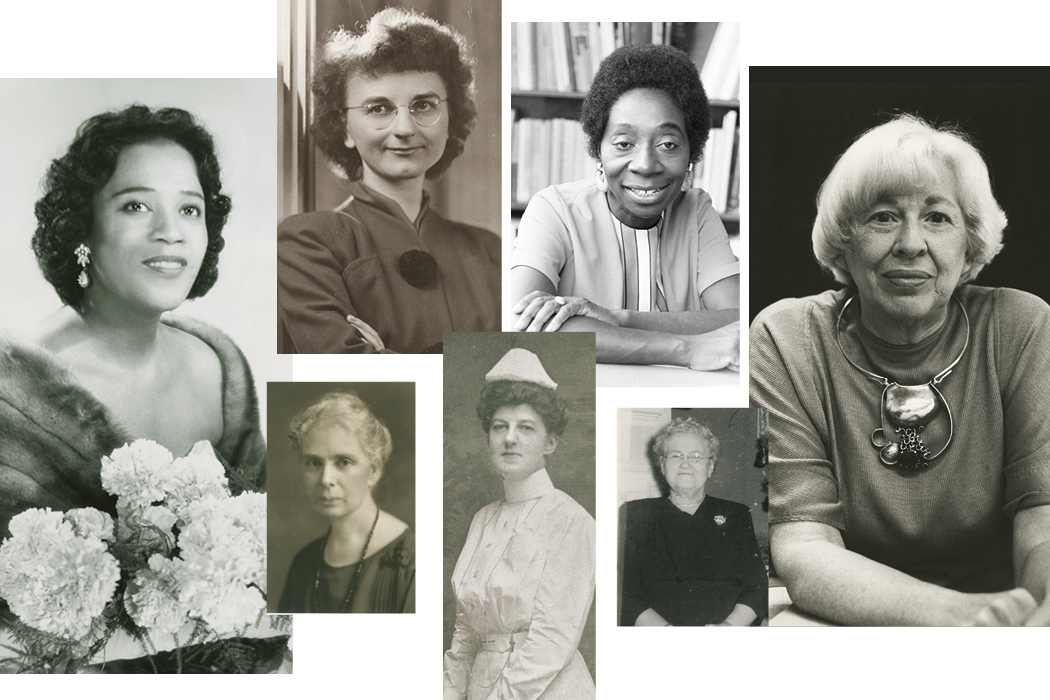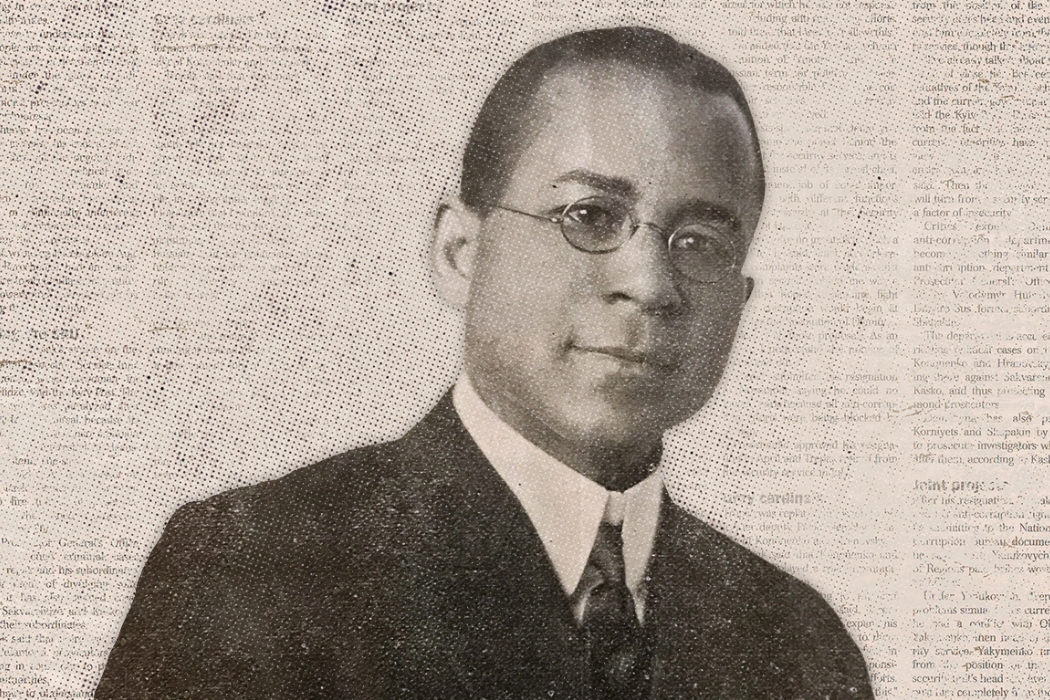7 Women Who Built IU

Throughout Indiana University’s 200 years, women have been groundbreaking researchers, influential administrators, renowned artists, and cornerstones of the campus community. But their names may not be as widely known as their male counterparts, and their contributions were not fully recognized by their contemporaries. Let’s change that.
Alma Eikerman
(1908 – 1995)
Artist. Advocate. Innovator.

When Alma Eikerman came to IU in 1947, she created the university’s metalsmithing and jewelry program, which to this day remains consistently ranked among the top 10 programs in the country.
As a teacher, she regularly advocated for her students, seeking more space and better equipment for them to work on labor-intensive techniques like hollowware. She also encouraged her students to participate in national competitions, where IU’s jewelry and metalsmithing program became synonymous with excellence.
Eikerman retired from IU in 1978. As an accomplished artist in her own right whose work is still on exhibit throughout the country—including at the Smithsonian American Art Museum and in the Eskenazi Museum of Art at IU—Eikerman’s legacy as an innovative artist, trailblazing woman, and influential teacher still runs deep.
Camilla Williams
(1919 – 2012)
A Lifetime of Firsts

As a Black woman born in the Jim Crow South, Camilla Williams used her talent and perseverance to become a world-renowned opera singer—the first Black woman to secure a contract with a major opera company in the U.S.
Her celebrated opera career included several City Opera productions, an international tour, and a contract with RCA Victor. She also used her talents to aid the civil rights movement: staging a concert in her hometown in 1963 to raise money to free jailed demonstrators; singing “The Star-Spangled Banner” at the March on Washington; and performing at Martin Luther King Jr.’s Nobel Peace Prize ceremony in 1964.
Williams retired from opera in 1971 and shifted her focus to education, arriving at IU in 1977, where she became the first Black professor of voice at IU. Williams received the IU President’s Medal for Excellence in 2009 and the Sagamore of the Wabash—the highest honor the governor of Indiana can bestow—in 2010.
Juliette Maxwell
(1861 – 1939)
Champion of Women’s Athletics

The granddaughter of David H. Maxwell, “the father of Indiana University,” Juliette Maxwell was the only woman to graduate from IU in 1883 with a degree in physical training. She returned to IU in 1893 to join the newly established Department of Physical Training for Women as an instructor. Three years later she was promoted to director.
Over her 35-year career at IU, Maxwell expanded academic and extracurricular athletic opportunities for women and lobbied the IU Board of Trustees for additional dollars in support of female student athletes. She helped establish the Women’s Athletic Association in 1913, and in 1916 was instrumental in securing a new athletic field and fieldhouse for women.
In 1922, she joined Lillian Gay Berry as the first two women in IU history to be promoted to professor.
Ethel P. Clarke
(1875 – 1970)
The Brains Behind Ball Residence

When Ethel P. Clarke became director of the IU Training School for Nurses in Indianapolis in 1915, there were only 17 students enrolled in the school. During Clarke’s tenure, the James Whitcomb Riley Hospital for Children was dedicated and the William H. Coleman Hospital for Women was built, necessitating more nurses—and larger living quarters for nurses in training.
Clarke spent many hours planning Ball Residence, personally ordering all furnishings and each piece of equipment for the building that would house 165 students, as well as classrooms, laboratories, offices, and a demonstration room.
At the end of Clarke’s tenure in 1931, she’d grown the program from 17 to 168 students, revised the curriculum, and helped create what is believed to be the only national honorary society of nursing in the United States.
Martha E. Dawson
(1924 – 2015)
Teaching Teachers How to Serve the Underserved

Martha E. Dawson began her teaching career in the midst of the Brown v. Board of Education Supreme Court case and decision—circumstances that would shape the mark she left on the world of education.
When Dawson began teaching at IU Bloomington in 1970, there were only 21 Black men on the faculty and no Black women. Shortly after she arrived, she launched the School of Education’s Urban Education program, which placed an emphasis on experience and was “designed to sensitize students to the needs of the poor.”
Students began training outside the classroom, tutoring disadvantaged Bloomington children in their homes in order to see their living conditions firsthand. Next, they would teach one day per week in an inner-city school in Indianapolis. In the summers, students would engage with underprivileged children during community programs.
Dawson’s recognition of the role that cultural sensitivity plays in the effectiveness of instruction laid the groundwork for the innovative, immersive opportunities that exist in the IU School of Education today.
Anna Harting Wells
(1882 – 1973)
Mother Wells

In 1948, Anna Harting Wells arrived in Bloomington for a monthlong visit with her son, then-IU President Herman B Wells. She never left, diving headfirst into a role as university hostess and de facto first lady for the unmarried President Wells.
“Mother Wells” hosted receptions and teas at Woodburn House, attended faculty and student functions across campus, and counseled student groups like the Mortar Board Society. On occasion, she’d replace her son at university events if he was double-booked. Her official university role extended beyond Bloomington as she traveled to places like Hawaii, Tokyo, Hong Kong, Thailand, and the Philippines with her son.
Barbara Shalucha
(1915 – 1992)
The Opposite of Garden Variety

Barbara Shalucha had a gift for growing things. As an assistant professor of botany at IU in 1948, she helped transform a mostly forgotten, one-acre alfalfa field at the edge of campus into the Hilltop Garden and Nature Center, a flourishing urban oasis where elementary school students learned natural science by planting crops and observing their growth cycles.
Hilltop gained an international reputation for its pioneering approach, and Shalucha was invited to share her ideas with educators and plant scientists throughout the world, spawning similar programs in China, Canada, Israel, and throughout Europe.
Over 10,000 young learners and 4,000 teachers took classes at Hilltop during Shalucha’s 37-year tenure. She even grew the center itself—from the approximate size of two city blocks to more than five acres.
If you would like to help elevate the recognition of distinguished IU women and minority alumni, please contact Rebecca Resetarits, executive director of Women’s Philanthropy at IU, at 812-855-1422 or rjmoorma@iu.edu. Or use the following Give Now link to support the IU Women’s Philanthropy Visibility Fund today.
This article was originally published in the fall 2020 issue of Imagine magazine, and was adapted from Women Who Built IU, a 2020 production of the IU Newsroom.
Tags from the story
Written By
Ryan Millbern




